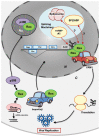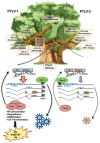HTLV-1 Rex: the courier of viral messages making use of the host vehicle
- PMID: 22973269
- PMCID: PMC3434621
- DOI: 10.3389/fmicb.2012.00330
HTLV-1 Rex: the courier of viral messages making use of the host vehicle
Abstract
The human T-cell leukemia virus type 1 (HTLV-1) is a retrovirus causing an aggressive T-cell malignancy, adult T-cell leukemia (ATL). Although HTLV-1 has a compact RNA genome, it has evolved elaborate mechanisms to maximize its coding potential. The structural proteins Gag, Pro, and Pol are encoded in the unspliced form of viral mRNA, whereas the Env protein is encoded in singly spliced viral mRNA. Regulatory and accessory proteins, such as Tax, Rex, p30II, p12, and p13, are translated only from fully spliced mRNA. For effective viral replication, translation from all forms of HTLV-1 transcripts has to be achieved in concert, although unspliced mRNA are extremely unstable in mammalian cells. It has been well recognized that HTLV-1 Rex enhances the stability of unspliced and singly spliced HTLV-1 mRNA by promoting nuclear export and thereby removing them from the splicing site. Rex specifically binds to the highly structured Rex responsive element (RxRE) located at the 3' end of all HTLV-1 mRNA. Rex then binds to the cellular nuclear exporter, CRM1, via its nuclear export signal domain and the Rex-viral transcript complex is selectively exported from the nucleus to the cytoplasm for effective translation of the viral proteins. Yet, the mechanisms by which Rex inhibits the cellular splicing machinery and utilizes the cellular pathways beneficial to viral survival in the host cell have not been fully explored. Furthermore, physiological impacts of Rex against homeostasis of the host cell via interactions with numerous cellular proteins have been largely left uninvestigated. In this review, we focus on the biological importance of HTLV-1 Rex in the HTLV-1 life cycle by following the historical path in the literature concerning this viral post-transcriptional regulator from its discovery to this day. In addition, for future studies, we discuss recently discovered aspects of HTLV-1 Rex as a post-transcriptional regulator and its use in host cellular pathways.
Keywords: B-23; CRM1; HIV-1 Rev; HTLV-1 Rex; HTLV-2; importinβ; post-translational regulator; retroviruses.
Figures





Similar articles
-
Expression of Alternatively Spliced Human T-Cell Leukemia Virus Type 1 mRNAs Is Influenced by Mitosis and by a Novel cis-Acting Regulatory Sequence.J Virol. 2015 Nov 18;90(3):1486-98. doi: 10.1128/JVI.02298-15. Print 2016 Feb 1. J Virol. 2015. PMID: 26581997 Free PMC article.
-
Nuclear export and expression of human T-cell leukemia virus type 1 tax/rex mRNA are RxRE/Rex dependent.J Virol. 2012 Apr;86(8):4559-65. doi: 10.1128/JVI.06361-11. Epub 2012 Feb 8. J Virol. 2012. PMID: 22318152 Free PMC article.
-
Human T lymphotropic virus type 1 regulatory and accessory gene transcript expression and export are not rex dependent.AIDS Res Hum Retroviruses. 2012 Apr;28(4):405-10. doi: 10.1089/aid.2011.0130. Epub 2011 Aug 5. AIDS Res Hum Retroviruses. 2012. PMID: 21819218 Free PMC article.
-
The human T-cell leukemia virus Rex protein.Front Biosci. 2005 Jan 1;10:431-45. doi: 10.2741/1539. Print 2005 Jan 1. Front Biosci. 2005. PMID: 15574380 Free PMC article. Review.
-
HTLV-1 Rex Tunes the Cellular Environment Favorable for Viral Replication.Viruses. 2016 Feb 24;8(3):58. doi: 10.3390/v8030058. Viruses. 2016. PMID: 26927155 Free PMC article. Review.
Cited by
-
Expression of Alternatively Spliced Human T-Cell Leukemia Virus Type 1 mRNAs Is Influenced by Mitosis and by a Novel cis-Acting Regulatory Sequence.J Virol. 2015 Nov 18;90(3):1486-98. doi: 10.1128/JVI.02298-15. Print 2016 Feb 1. J Virol. 2015. PMID: 26581997 Free PMC article.
-
Forefront studies on HTLV-1 oncogenesis.Front Microbiol. 2013 Jun 18;4:156. doi: 10.3389/fmicb.2013.00156. eCollection 2013. Front Microbiol. 2013. PMID: 23785364 Free PMC article. No abstract available.
-
A novel one-class SVM based negative data sampling method for reconstructing proteome-wide HTLV-human protein interaction networks.Sci Rep. 2015 Jan 26;5:8034. doi: 10.1038/srep08034. Sci Rep. 2015. PMID: 25620466 Free PMC article.
-
Development and validation of a new high-throughput method to investigate the clonality of HTLV-1-infected cells based on provirus integration sites.Genome Med. 2014 Jun 27;6(6):46. doi: 10.1186/gm568. eCollection 2014. Genome Med. 2014. PMID: 25028597 Free PMC article.
-
Multifaceted functions and roles of HBZ in HTLV-1 pathogenesis.Retrovirology. 2016 Mar 15;13:16. doi: 10.1186/s12977-016-0249-x. Retrovirology. 2016. PMID: 26979059 Free PMC article. Review.
References
-
- Abe M., Suzuki H., Nishitsuji H., Shida H., Takaku H. (2010). Interaction of human T-cell lymphotropic virus type I Rex protein with Dicer suppresses RNAi silencing. FEBS Lett. 584 4313–4318 - PubMed
-
- Adachi Y., Copeland T. D., Hatanakall M., Oroszlansii S. (1993). Nucleolar targeting signal of Rex protein of human T-cell leukemia virus type I specifically binds to nucleolar shuttle protein B-23. J. Biol. Chem. 268 13930–13934 - PubMed
-
- Adachi Y., Copeland T. D., Takahashi C., Nosaka T., Ahmed A., Oroszlan S., Hatanaka M. (1992). Phosphorylation of the Rex protein of human T-cell leukemia virus type I. J. Biol. Chem. 267 21977–21981 - PubMed
-
- Adachi Y., Nosaki T., Hatanaka M. (1990). Protein kinase inhibitor H-7 blocks accumulation of unspliced mRNA of human T-cell leukemia virus type I (HTLV-I). Biochem. Biophys. Res. Commun. 169 469–475 - PubMed
-
- Ahmed Y. F., Gilmartin G. M., Hanly S. M., Nevins J. R., Greene W. C. (1991). The HTLV-I Rex response element mediates a novel form of mRNA polyadenylation. Cell 64 727–737 - PubMed
LinkOut - more resources
Full Text Sources
Other Literature Sources

